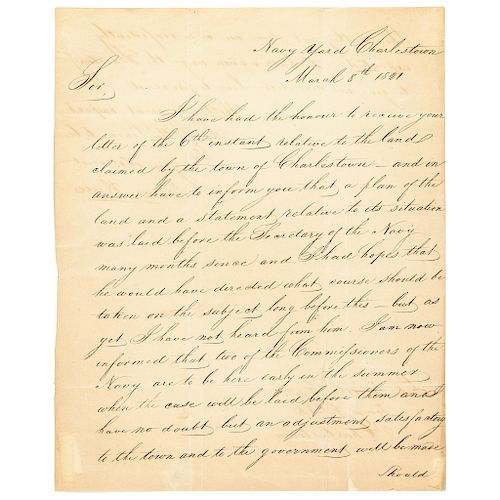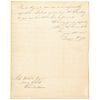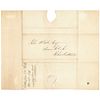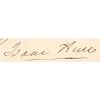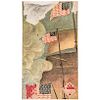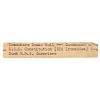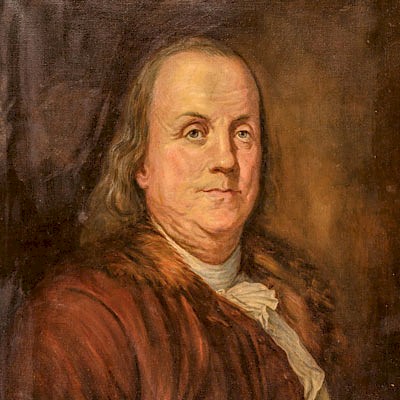1821 Commodore Isaac Hull ALS Regarding U.S. Navy - Charleston Land Negociations
Lot 48
Estimate:
$1,000 - $2,000
Absentee vs Live bid
Two ways to bid:
- Leave a max absentee bid and the platform will bid on your behalf up to your maximum bid during the live auction.
- Bid live during the auction and your bids will be submitted real-time to the auctioneer.
Bid Increments
| Price | Bid Increment |
|---|---|
| $0 | $10 |
| $200 | $20 |
| $300 | $25 |
| $500 | $50 |
| $1,000 | $100 |
| $2,000 | $200 |
| $3,000 | $250 |
| $5,000 | $500 |
| $10,000 | $1,000 |
| $20,000 | $2,000 |
| $30,000 | $2,500 |
| $50,000 | $5,000 |
| $100,000 | $10,000 |
| $200,000 | $20,000 |
| $300,000 | $25,000 |
| $500,000 | $50,000 |
About Auction
By Early American History Auctions
Aug 24, 2019
Set Reminder
2019-08-24 12:00:00
2019-08-24 12:00:00
America/New_York
Bidsquare
Bidsquare : Autographs, Colonial Currency, Political Americana, Historic Guns
https://www.bidsquare.com/auctions/early-american-history-auctions/autographs-colonial-currency-political-americana-historic-guns-4347
Historic Autographs • Colonial Currency • American Civil War Colonial Era • Revolutionary War • Political Americana • Black History Early American History Auctions auctions@earlyamerican.com
Historic Autographs • Colonial Currency • American Civil War Colonial Era • Revolutionary War • Political Americana • Black History Early American History Auctions auctions@earlyamerican.com
- Lot Description
Autographs
1821 Commodore Isaac Hull Autograph Letter Signed RE: U.S. Navy and Town of Charlestown Land Negotiations
COMMODORE ISAAC HULL (1773-1843). Commodore in the United States Navy, Commanded U.S. naval warships including USS Constitution ("Old Ironsides") and saw service with the French Republic 1796-1800; the Barbary Wars (1801-1805, 1815); and the War of 1812 (1812-1815), with Great Britain; Commandant of the Washington Navy Yard, and later the Commodore of the Mediterranean Squadron, the Battle of USS Constitution vs HMS Guerriere on August 19, 1812, the most important single ship action of the War of 1812 that made Isaac Hull a national hero.
March 8th, 1821-Dated, Important U.S. Navy Content Commodore Isaac Hull Autograph Letter Signed, "Isaac Hull" as Commander of the Navy Yard Charlestown (Boston, Mass.), with Original Transmittal Envelope, Choice Very Fine. This beautifully handwritten letter is penned in rich brown ink on clean wove period paper, 2 pages, measuring about 9.75" x 8", to John Kettle Esqr. Town Clerk of Charlestown. This appears to be a critical response to a prior Letter sent by the Town of Charlestown regarding a land claim dispute involving the Navy Yard at Charlestown, which Isaac Hull was now in Command. It reads, in full:
"Navy Yard Charlestown - March 8th 1821 --- Sir, --- I have had the honour to receive your letter of the 6th instant, relative to the land claimed by the town of Charlestown - and in answer have to inform you that a plan of the land and a statement, relative to its situation was laid before the Secretary of the Navy many months since and I had hopes that he would have directed what course should be taken on the subject long before this - but as yet, I have not heard from him. I am now informed that two of the Commissioners of the Navy are to be here early in the Summer, when the case will be laid before them and I have no doubt, but, an adjustment, satisfactory to the town and to the government, will be made. Should they not, come on as is confidently expected, I shall again urge the Secretary to give me direction how to proceed. -- With very great respect, I have the honour to be - Sir - your obdt. Servt. - (Signed) Isaac Hull".
Together with its original Manuscript Address Transmittal Envelope, with Docket reading, in full: "Letter from Comr. Hull - March 8, 1821 - respecting Town Land". 1786, the first bridge across the Charles River connected Boston with Charlestown. An 87-acre (35 ha) Navy Yard was established in 1800. (2 items)
On June 17, 1775, the Charlestown Peninsula was the site of the Battle of Bunker Hill, named for a hill at the northwest end of the peninsula near Charlestown Neck. British troops unloaded at Moulton's Point and much of the battle took place on Breed's Hill, which overlooked the harbor from about 400 yards off the southern end of the peninsula. The town, including its wharves and dockyards, was almost completely destroyed during the battle by the British.
The town was not appreciably rebuilt until the end of hostilities but, in 1786, the first bridge across the Charles River connected Boston with Charlestown. An 87-acre (35 ha) Navy Yard was established in 1800; Charlestown State Prison opened in 1805. The Bunker Hill Monument was erected between 1827 and 1843 using Quincy granite brought to the site by a combination of purpose-built railway and barge.
Isaac Hull was born in Derby, Connecticut. Early in life he joined his mariner father, Joseph, on local voyages and longer trips to the West Indies. After his father died while still young, Isaac was adopted by his uncle William Hull, a veteran of the American Revolutionary War.
During the mid-1790s, the young Hull commanded several merchant vessels, losing some to French privateers. He was commissioned a Lieutenant in the newly-formed United States Navy in March 1798 and distinguished himself during the next two years while serving on board the frigate Constitution in the Quasi-War with France.
When troubles with the Barbary states heated up in 1802, he went to the Mediterranean as First Lieutenant of the frigate Adams. Hull later commanded the schooner Enterprise and the brig Argus, receiving promotion to the rank of Master Commandant in 1804 and to Captain in 1806. During the next few years, he supervised the construction of gunboats and, in 1809 and 1810, was successively given command of the frigates, Chesapeake, President and Constitution.
A Special Medal was Awarded to Hull by the United States Congress
Captain Hull's time on the Constitution was eventful. He took the ship on a European cruise in 1811-1812, returning home before the War of 1812 broke out between the United States and Great Britain. An enemy squadron closely pursued his ship off the East Coast in July, but Hull skillfully evaded them. On August 19, 1812, Constitution encountered the British frigate HMS Guerriere at sea and pounded her to a wreck in an action that electrified the Nation and demonstrated that the small U.S. Navy was a worthy and dangerous opponent for Britain's otherwise overwhelming maritime might.
Hull's tenure as Commandant of the Charlestown Navy Yard (Massachusetts, known as Boston Navy Yard) was marred and hindered by his lack of familiarity with the administration of a large shore installation, the management of the civilian workforce and by the moves to dislodge him by some of his senior and junior naval officers. A number of these officers and senior civilians made public accusations questioning Hull's command. In view of the serious nature of their charges a Naval Court of Inquiry met in Charlestown during August 1822 to consider the accusations brought against Hull. On 15 October 1822 the court found Hull had acted properly and within his scope of authority and in his official duties had been "correct and meritorious."
Nevertheless, the court cautioned Hull regarding placing his personal property in public stores and the employment of navy yard mechanics and laborers for private purposes. But the bitterness of the affair never really left Hull for as he wrote "This yard is much improved and in fine order for whoever may take it. I am tired of this kind of life and particularly of this place, and have nothing but constant quarrels with the Charleston people." During 1823-1827, he commanded the Pacific Squadron operating out of South America aboard USS United States.
Hull commanded the Portsmouth Navy Yard at Kittery, Maine, for the rest of the War of 1812, then briefly served on the Board of Navy Commissioners in Washington, D.C. before taking over leadership of the Boston Navy Yard. During 1823-1827, he commanded the Pacific Squadron operating out of South America. Commodore Hull's next assignment, as Commandant of the Washington Navy Yard, ran from 1829 until 1835. Between 1839 and 1841, he commanded the Mediterranean Squadron.
Rendered unfit for further service by age and ill health, he spent the next two years on leave. Commodore Isaac Hull died in Philadelphia, Pennsylvania and is buried there in Laurel Hill Cemetery.
- Shipping Info
-
Early American provides in-house worldwide shipping. Please contact us directly if you have questions about your specific shipping requirements.
-
- Buyer's Premium



 EUR
EUR CAD
CAD AUD
AUD GBP
GBP MXN
MXN HKD
HKD CNY
CNY MYR
MYR SEK
SEK SGD
SGD CHF
CHF THB
THB